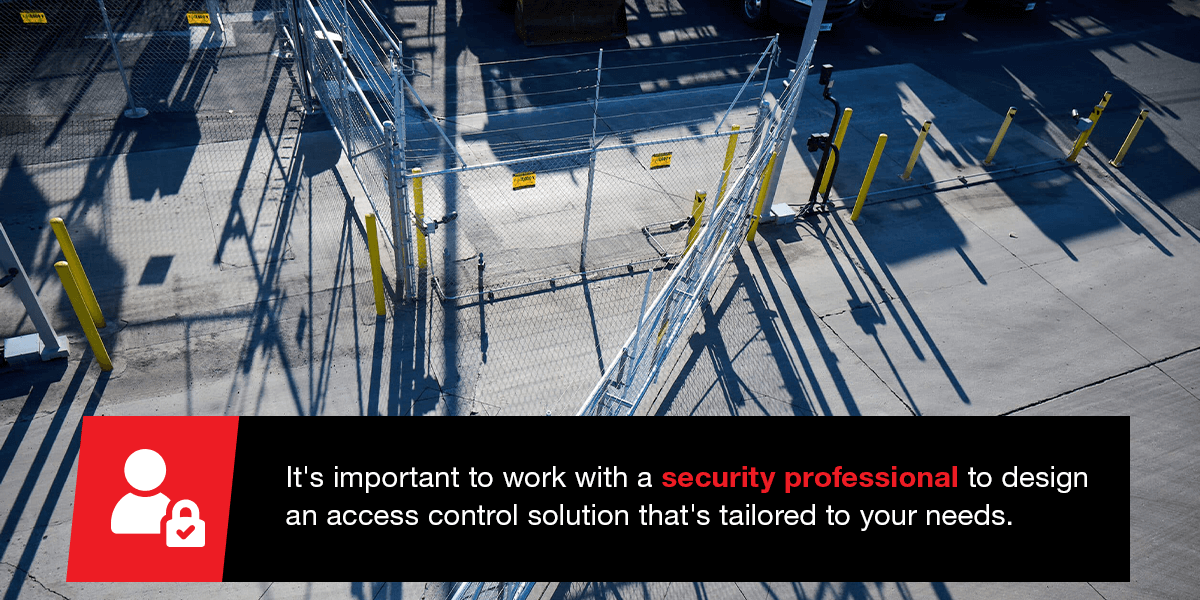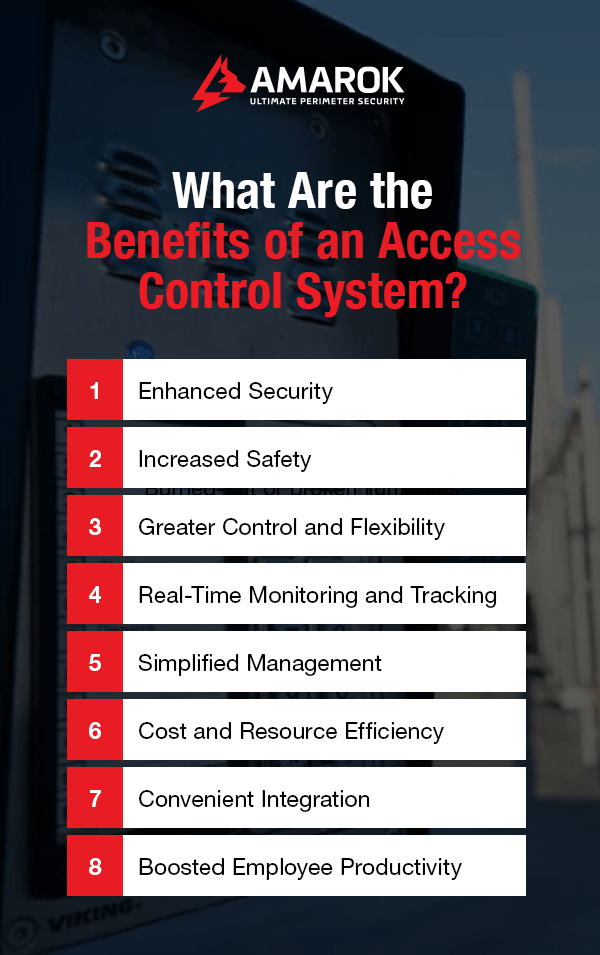Property crime is the most common offense in the United States, with nearly 7 million incidents occurring annually. Businesses are often targeted by criminals seeking expensive equipment, components, cargo, or other assets. For example, cargo and auto part theft skyrocketed in 2023, with thieves targeting catalytic converters and CPC modules.
Businesses must take a strategic and layered approach to guard against property crime effectively. Access control is a vital component of crime prevention, yet it doesn’t always get the attention it deserves.
According to a 2023 survey conducted by ASIS International, security consultants ranked access control 9 out of 10 on a scale of importance, with 10 representing “critically important” security measures. However, 68% of consultants say that companies do not place enough emphasis on access control.
Whether your business has experienced repeated access-related incidents or you want to proactively address crime, the potential benefits of access control are plentiful. Learn more about why this solution is essential to a robust security strategy.
What Is an Access Control System?
An access control system encompasses various technologies designed to allow approved individuals into a secure space while denying access to unauthorized persons. It’s primarily used as a proactive security control to deter or delay an intrusion. Access control technology is often combined with video surveillance cameras and intrusion detection systems to further enhance security.

That said, access control systems are not stand-alone solutions. Businesses must utilize an effective barrier to protect their entire perimeter and keep criminals from walking around a controlled gate or door. For example, electric fences are excellent visual and physical deterrents that integrate easily with access control systems and discourage criminals from attempting a breach. If a potential intruder dares to touch an electric security fence, they’ll experience a safe but memorable shock.
Access Control Technology
Properties have varying access control needs. Where a smaller property may only need to control access at a single entry point, a large enterprise may have several buildings and paths to control, requiring a more complex, interconnected system. It’s important to work with a security professional to design an access control solution that’s tailored to your needs.
In general, an access control system requires the following core components:
- Door or gate: Access control systems are often connected to motorized gates at truck yards, self-storage facilities, and other commercial and industrial properties. Once an authorized person passes the gate, they may face another access control device at the building’s door. This multi-layered approach enables tight access control of specific areas.
- Locking mechanism: The door or gate must include a locking device, which is controlled by a credential reader. Doors or gates may open automatically when access is granted.
- Credential reader: A credential reader is an electronic device, like a keypad or card reader, that converts a user’s credentials into a data signal. It sends the data to a computing system, which verifies the information, determines whether the user is authorized for that area, and unlocks the gate or door to approved individuals.
- Credentials: A person’s credential enables access-controlled entry points to unlock. Depending on the type of reader used, credentials may include a PIN, key fob, ID badge, or encrypted proximity card. Some systems utilize Bluetooth technology, enabling users to gain access through their mobile devices.
- Credential database: Access control systems must have a database for storing credential information like PIN codes. Software that integrates a database and user management into a single platform allows supervisors to update permissions and generate activity reports easily.

The following auxiliary equipment serves important roles in enhancing an access control system and overall security:
- Intrusion detection system: Many access control systems incorporate an intrusion detection system, which notifies security personnel if a door has been forced open. Intrusion detection solutions include motion detectors, door contacts, and automated notifications.
- Intercoms: An intercom system allows security personnel to communicate with visitors at an entry point and verify their identity. Intercoms can be paired with video surveillance cameras, equipping security staff to authenticate authorized personnel or detect suspicious behavior quickly.
- License plate recognition: Businesses can implement license plate recognition (LPR) technology to grant vehicle access at the gate automatically. LPR can also be used to alert personnel if banned vehicles are attempting to enter the property so they can take the appropriate action.
- Surveillance cameras: Positioning video surveillance cameras at access control points is vital to capturing evidence of an attempted breach or detecting criminals that tailgated their way in. Cameras can also be used in conjunction with real-time monitoring software so management or security personnel can grant or deny access remotely.
What Are the Benefits of an Access Control System?
Any business that needs to protect its assets can benefit from access control. Here’s why:

1. Enhanced Security
As part of a well-rounded security framework, access control systems ensure that only authorized personnel enter specific areas. In the ASIS International survey, over 70% of security professionals said they face only one to five access-related incidents annually thanks to their access control system.
There are a few reasons why an access control system successfully prevents unauthorized entry. First, they serve as a visual deterrent, letting criminals know they won’t get into a property easily and discouraging them from trying. Access control systems also make it extremely challenging to bypass a credential reader. If a criminal still attempts to get through a controlled entry point, security measures like intrusion detection or video surveillance activate and help prevent a major incident.
2. Increased Safety
If there’s an emergency at your facility, such as a fire, access control systems can help keep your employees safe. Some access control systems can be integrated with fire alarms and programmed to unlock doors automatically, enabling rapid evacuation. Security personnel may also lock certain areas remotely through access control technology to protect employees from an internal threat, like an armed intruder.
Access control systems also enable you to limit access to hazardous areas, only allowing trained personnel to enter and keeping visitors and untrained employees safe. Such a setup can help you comply with safety standards established by the Occupational Safety and Health Administration (OSHA).
For example, under OSHA’s General Duty Clause, each employer must ensure the workplace is free of recognized hazards likely to cause serious harm or death. Access control systems can be designed to support compliance with this clause, as well as other safety regulations and industry guidelines.
3. Greater Control and Flexibility
Modern access control systems are made to adapt to your security needs. With cloud-based security management software, for instance, you can efficiently and remotely adjust credential data based on various roles, times, and locations. This feature allows you to customize your access control system from anywhere or control entry at multiple locations simultaneously — all in a single platform.
With more control over your access points, you can increase convenience for your employees and vendors. For example, you can assign temporary access codes to vendors which automatically expire when a contract ends. That way, vendors don’t have to wait for security staff to open the gate. You can also allow certain employees to enter the property at any hour, enabling flexible scheduling.
4. Real-Time Monitoring and Tracking
When a person uses their credentials to access your property, the system’s database is automatically updated to reflect event details, like user identification, time, and date. These automatic updates allow you to see who enters specific areas in real-time. Keeping an updated log of access events is crucial to aid investigations or audits.
With remote monitoring capabilities, you or your security team can track real-time data remotely and know who’s at the property 24/7. Some software includes options to notify your mobile device if there’s an attempted breach so you can react promptly.
5. Simplified Management
With smart access solutions, managers don’t have to worry about changing the lock and reissuing new keys to all employees if one worker loses their key, saving the company time and money.
Using an access control system, you can void a lost credential in your database and only reissue a new PIN or ID to the affected person. Likewise, you can easily remove former employees’ credentials from the system to deny their access and streamline their offboarding.
Additionally, if an authorized person contacts you to grant them access from afar, you can use a remote-capable access control system to unlock a gate or door from anywhere. This feature can save managers the time and trouble of having to arrive on-site to let an employee in.
6. Cost and Resource Efficiency
If you’re concerned about the cost of an access control system, know that it can yield a positive ROI for various reasons. Controlling site access can help prevent theft, vandalism, and other property crimes, saving you from spending valuable time submitting insurance claims. Having fewer claims may contribute to lower insurance premiums. If some of your assets aren’t insured, access control removes the financial burden of replacing stolen goods by minimizing the risk of theft.
By tightly controlling the different areas at your facility, you lessen the chance of accidents resulting from unauthorized access. For example, you can keep unauthorized employees from entering hazardous material storage areas, guarding them against accidental injuries. Doing so lowers the likelihood of liability claims or fines related to regulatory noncompliance.
Lastly, access control systems reduce costs associated with security personnel by automating access management and enabling remote supervision. Rather than pay security guards to stay on-site and monitor your facility 24/7, you can use a comprehensive security system with integrated access control to stop crime before it happens. If a criminal attempts a breach, your system’s technology can notify the appropriate party immediately.
7. Convenient Integration
Modern access control technology easily integrates with other security measures, such as video surveillance cameras and alarm systems, for whole-property protection. Security professionals can efficiently install access control technology and connect it to other devices to develop a more robust security posture.
Each part of your security system works in harmony to offer maximum protection. For example, if an unauthorized person tries to guess a PIN code, your access control system can trigger a nearby security camera to start recording. That way, you’ll capture visual evidence of an attempted breach, which you can use to verify the incident with law enforcement if needed.
Seamless integration also means you can manage your access control system and other security devices from a centralized platform, which gives you more options to optimize security management and ensure all vulnerabilities are addressed.
8. Boosted Employee Productivity
Access control isn’t just about keeping people out — it makes it easier to let the right people in. With a fine-tuned system and proper training, employees can easily come and go without increasing security risks. If an employee needs to enter a building at a location miles away and you have an enterprise-wide system, granting them access is easy, streamlining their entry and enabling them to address urgent tasks.
Access control systems also help bring employees peace of mind and a greater sense of safety so they can focus on doing their best work. Keeping sensitive areas restricted to select personnel is an excellent way to minimize distractions and support long-term projects requiring extended equipment setup.
Choose AMAROK for World-Class Access Control
For many businesses, access control is nonnegotiable to protect assets and ensure employee safety, but it’s not a stand-alone solution. Instead, an access control system is a vital part of proactive, multilayered security — the most effective approach to preventing crime.
If you need capable, cost-effective access control, turn to AMAROK. We’re a security-as-a-service provider specializing in electric fencing and customized, comprehensive security solutions. Our gate access control systems seamlessly integrate with automated gates, fencing, video surveillance cameras, and alarm systems, creating an impenetrable barrier and formidable visual deterrent. We thrive on amplifying our customers’ perimeter security, and we help them achieve a 5X ROI on average.





